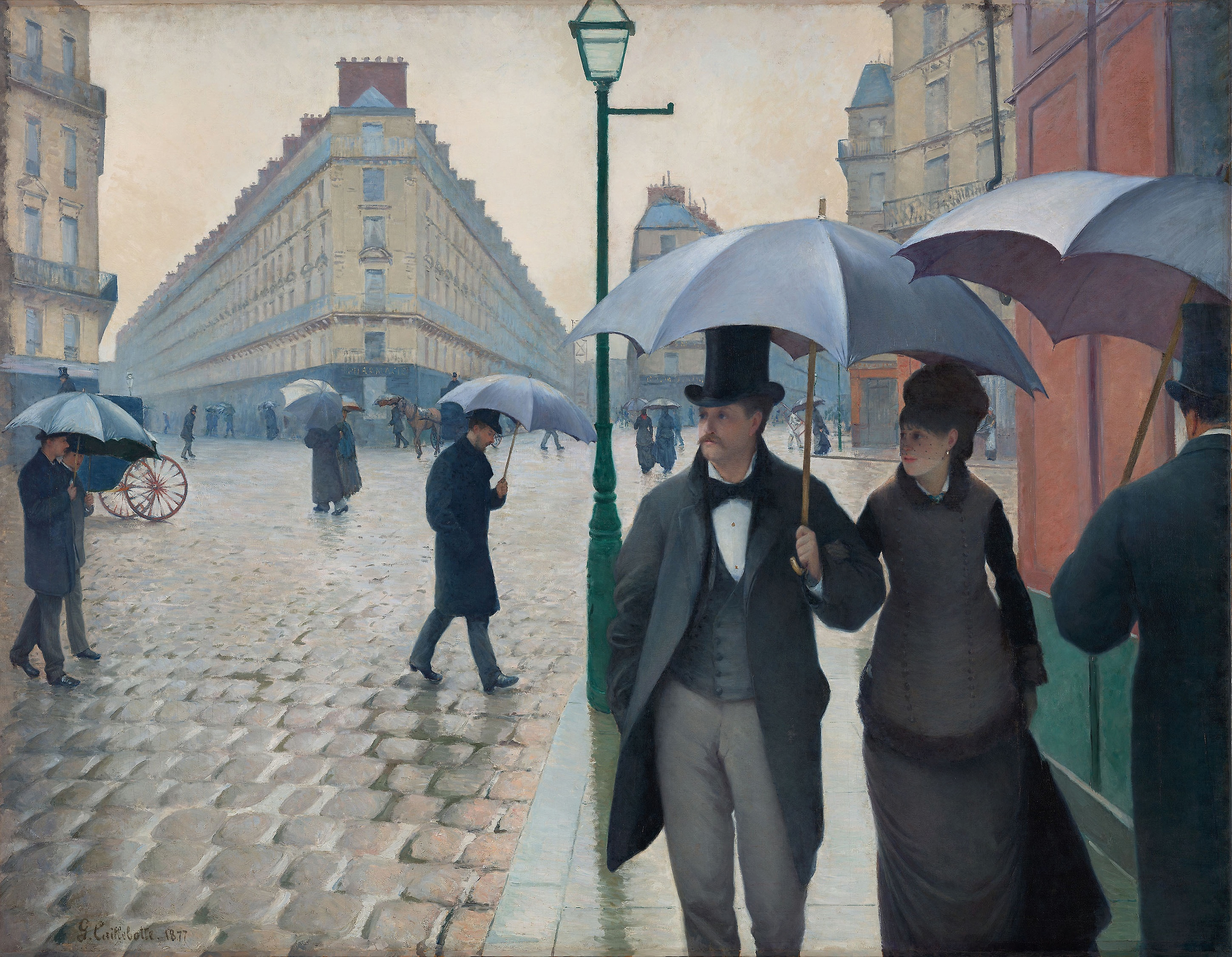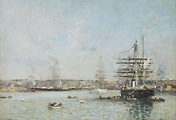













구스타브 칼리보트(Gustave Caillebotte), 프랑스, 화가, 1848-1894
우산을 받쳐 들고 파리의 광장을 걷는 커플, 150년 전 그림이지만 무척 현대적인 패션입니다. 근대화의 물결이 일던 당시, 파리는 새로운 도시로 변모하던 시절이었습니다. 그래서 '카유보트'의 그림은 도시적 풍경을 담은 작품들이 많습니다.
모네가 증기기관차를 그릴 무렵, 카유보트는 기차역의 철제 다리를 그리며 도시산업화를 묘사했습니다. “비 오는 파리 거리”의 무대가 된 ‘더블린 광장 (Place de Dublin)’은, 길바닥의 조약돌만 바뀌었을 뿐 150년 전이나 지금이나 거의 같은 모습이네요.
카누 경기 우승자답게 보트 타는 남성들도 많이 그렸죠. 부유하게 자란 ‘카유보트’는 르누아르와 모네·마네 등 친구들의 그림을 사들이거나 스튜디오 임대료를 지불해 주며 화가들에게 큰 힘이 되었답니다. 그리고 카유보트는 훗날 인상주의 컬렉션을 국가에 기증했습니다.
About Him
Gustave Caillebotte was one of the leading figures of the French Impressionist movement, although he painted more realistically than other impressionists. He was born in 1848 into a wealthy upper-class Parisian family. Despite being a trained engineer, he took an interest in painting and began studying under painter Léon Bonnat and later entered the École des Beaux-Arts. In 1874, he befriended Impressionist painters Claude Monet and Pierre-Auguste Renoir, and gradually became acquainted with art outside of academic circles.
Caillebotte’s earliest masterpiece The Floor Scrapers (1875) is one of the first paintings depicting the urban working class. Although the painting demonstrated Caillebotte’s academic training, it was rejected by the Salon in 1875. The Jury, who was likely shocked by the crude realism of the painting, criticized the artist’s ‘vulgar’ choice of subject. The rejection propelled Caillebotte to join the Impressionists, and he participated in the second Impressionist exhibition in 1876, where he presented several paintings including The Floor Scrapers.
Throughout the 1870s, Caillebotte focused on depicting the modern urban environment of Paris, a result of the sweeping renovation commissioned by Emperor Napoleon III and directed by his prefect of Seine, Baron Georges Haussmann. Large canvases like Le Pont de l’Europe (The Europe Bridge) (1876) and Paris Street; Rainy Day (1877) shows the urban landscape of Paris populated by the bourgeois and the working class. Although these were typical Impressionist subjects, Caillebotte’s meticulous and crisp brushwork stood in contrast to the free and quick brushwork of colleagues like Monet and Renoir. Rather than creating the impression of a dynamic and fleeting moment, Caillebotte’s paintings capture a frozen time, resembling photographic snapshots.
Caillebotte’s work was characterized by his bold use of perspective: he experimented with expanded perspectives, sharp angles, and tilted vantage points. The artist was influenced by the advent of photography, sometimes using photographs as source material and imitating photographic effects such as cropping and zooming in. He also showed an interest in Japanese prints, which influenced his compositions and led him to experiment with flattened forms. These experiments can be seen in paintings such as View of Roofs (Snow Effect) (1878) and The Boulevard Viewed From Above (1880).
In the latter half of his career, Caillebotte’s brushwork became freer and looser, resembling the style of his Impressionist colleagues. He painted a variety of subjects, rural landscapes, boating scenes, still-lifes, and portraits. Many of his later works were scenes surrounding his property at Petit-Gennervillers, on the banks of the Seine near Argenteuil. Notable examples include Sailing boats at Argenteuil (1888) and The Plain of Gennevilliers from the Hills of Argenteuil (1888).
In addition to being an active member of the Impressionist group, Caillebotte was also an important patron and benefactor of the movement. After receiving his inheritance, he helped to fund, organize, and promote Impressionist exhibitions as well as purchased the works of Monet, Renoir, Camille Pissarro, Edgar Degas, Alfred Sisley, and others. Caillebotte died of pulmonary congestion in 1894 at the age of 45.
Despite his pivotal role in the Impressionist movement, Caillebotte is the least known of the French Impressionists. Being of financial means, Caillebotte never depended on his art for income, overtime he exhibited less frequently, and he also had no reason to sell his paintings. Because of this, most of his works remained out of the public eye and rarely entered public collections. In his will, Caillebotte bestowed his collection to the French state, and the collection became a cornerstone of Impressionist art in French national museums. In part, it was his generous contribution and role as an art benefactor that overshadowed his artistic accomplishments. Around seventy years after his death, art historians began reassessing Caillebotte’s oeuvre, studying and acknowledging his contribution to Impressionism.
외젠 부댕(Eugene Boudin), 프랑스, 화가, 1824-1898
외젠 부댕(Eugene Boudin), 프랑스, 화가, 1824-1898항해사의 아들로 태어난 프랑스의 '외젠 부댕'은 어린 시절 직접 배에서 일을 하기도 했습니다. 그래서 바다 풍경이 많죠. 원래 사실주의 화가였지만
mkpark03.tistory.com
라라 파울루센(Lara Paulussen), 독일, 일러스트레이터, 1988-현재
라라 파울루센(Lara Paulussen), 독일, 일러스트레이터, 1988-현재독일 일러스트레이터 '라라 파울루센'은 애니메이션 같은 작품을 창작합니다. 프리랜서로 활동하는 그녀는 잡지 등 출판물을 위한 일
mkpark03.tistory.com
키스 반 동겐(Kees van Dongen), 네덜란드, 화가, 1877-1968
키스 반 동겐(Kees van Dongen), 네덜란드, 화가, 1877-1968네덜란드 태생의 '키스 반 동겐'은 감각적인 여성 초상화로 명성을 얻은, 야수파 화가입니다. 파리에서 지내던 중, 아내가 딸을 데리고 네덜란
mkpark03.tistory.com
'생활 > 예술' 카테고리의 다른 글
| 앤디 워홀(Andy Warhol), 미국, 미술가, 1928-1987 (4) | 2025.05.20 |
|---|---|
| 김영재, 한국, 화가, 1929-2023 (0) | 2025.05.19 |
| 외젠 부댕(Eugene Boudin), 프랑스, 화가, 1824-1898 (0) | 2025.05.16 |
| 라라 파울루센(Lara Paulussen), 독일, 일러스트레이터, 1988-현재 (0) | 2025.05.16 |
| 키스 반 동겐(Kees van Dongen), 네덜란드, 화가, 1877-1968 (1) | 2025.05.16 |




댓글